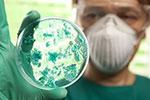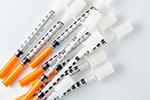
The information provided here discusses the management of infectious waste: how infectious waste is defined, who generates it and the statutory or regulatory requirements for permitting, proper treatment, packaging, transporting and disposing of this waste in Missouri. For additional information concerning infectious waste management and disposal, please call the Waste Management Program at 573-751-5401.
What is Infectious Waste?
Infectious Waste is defined in the Missouri Solid Waste Management rules as a waste capable of transmitting an infectious disease to a person because it contains strong and numerous enough pathogens that someone who comes in contact with the waste could get a disease from it.
You often hear infectious waste referred to as “regulated medical waste” or “healthcare waste,” but a lot of the waste generated by medical or healthcare facilities isn’t potentially infectious and regulated, so using those terms is inaccurate. Infectious waste is a much smaller subset of waste generated by medical facilities, such as hospitals, doctor’s offices, dental offices, veterinary clinics, laboratories and various medical clinics or even waste generated at research laboratories. Non-medical or healthcare-related entities also generate infectious waste: schools, hotels, motels, tattoo businesses and manufacturers, to name just a few.
Infectious waste includes the following:

|

|

|

|

|

|
| Waste from patients who have diseases that are capable of being transmitted to others. | Contaminated surgical, dialysis and laboratory wastes generated while a patient has a disease that may be transmitted to others via the wastes. | Cultures and stocks of infectious agents and associated biologicals, when discarded. The waste includes dishes and devices used during the culturing process. | Tissues, organs, body parts and body fluids removed during surgery or autopsy (also animal carcasses, body parts and bedding from animals contaminated with infectious agents that may be transmitted to humans.) | All discarded human blood and blood products, including serum, plasma and other components known or suspected to be contaminated with an infectious agent that may be passed to humans. | Discarded "sharps" such as hypodermic needles, syringes and scalpel blades - even broken glass or other sharp items that may have come in contact with infectious materials. Unused sharps are included in this category. |
General Information
Infectious waste is considered a non-hazardous waste that is regulated primarily by two state agencies:
- The Department of Health and Senior Services regulates infectious waste management in hospitals, defines infectious wastes for those entities who generate small quantities of the waste, and reviews infectious waste treatment methods for approval.
- The Department of Natural Resources’ Waste Management Program regulates infectious waste packaging, transportation, tracking/manifesting, disposal, and issues permits for infectious waste treatment or disposal facilities.
The statutory and regulatory requirements governing infectious waste management and disposal in Missouri are in the Missouri Solid Waste Management Law, Sections 260.203 and 260.204 RSMo and the Missouri Solid Waste Management regulations, 10 CSR 80-7.010.
What activities require a permit from the Waste Management Program to operate in compliance with the Missouri Solid Waste Management Law and regulations?
Activities that may require a permit include: the treatment of infectious waste to render it innocuous and consolidating/combining multiple loads of infectious waste from small box trucks into trailers for long-distance hauling to make transportation more economical and efficient. The permit to conduct either of these activities is called an infectious waste processing facility permit.
There may be other permits required to operate an infectious waste processing facility. It is the processing facility owner’s or operator’s responsibility to determine the types of permits or licenses that may be required to operate the facility in compliance with all federal, state and local requirements.
Untreated infectious waste may not be disposed of in any landfills in Missouri, except when the waste is generated by an individual and placed in that individual’s household waste to be picked up by the waste service provider. All other generators of infectious waste must treat the waste prior to disposal at a permitted sanitary landfill or transportation to a permitted infectious waste treatment or disposal facility. Treatment may be by incineration, steam sterilization or other department-approved method. Information concerning infectious waste treatment or transportation is available below.
Regulatory requirements for infectious waste packaging, transportation, tracking or manifesting, treatment and disposal, or exemptions to those requirements, are generally based upon the type of entity generating the waste and the amount of infectious waste generated. This results in three broad classifications of generators of infectious waste: individuals who generate the waste, small-quantity infectious waste generators and large-quantity infectious waste generators. Information is provided below regarding the requirements and exemptions allowed for each generator type.
Infectious Waste Management and Disposal for Individuals

Individuals who generate infectious waste at home are largely exempt from regulatory requirements for treatment, transportation, tracking and disposal, but they must properly package any sharps generated at their residence. They must place the sharps in a sharps container and seal it to prevent accidental injury to anyone coming in contact with it. Leak-resistant containers must be closable, have a tight-fitting lid and be leak-proof on the bottom and sides. If sharps containers are not available, another packaging option for individuals only is to use a thick-walled plastic container, such as a laundry detergent bottle - it is closable, has a tight-fitting lid and is leak-proof on the bottom and sides. Detergent bottles are recommended for this use over plastic milk cartons or soda bottles because they have thicker sides and bottoms that will better prevent the sharps inside from poking through the containers to stick anyone coming into contact with the container. Tape the container shut and write on the outside with a heavy waterproof marker, “Do not recycle,” and place it in your household trash so that the container will not inadvertently be retrieved from the trash to be recycled.

Other infectious waste, such as blood-saturated bandages or packing materials, saturated paper towels, paper wastes contaminated with saliva, phlegm, sputum or other liquid contamination generated by a person with an infectious disease, must be packaged so anyone touching the waste container won’t come in contact with the waste. The best way to package these types of infectious wastes is to place the wastes into a plastic bag (it does not matter what color), then tie the bag off as shown in the photo on the right. Tying the bags off this way is better than using garbage bags with drawstrings and tying the bags up in that manner because even when the drawstrings are pulled tight, there is still a hole in the top of the bag that allows anyone picking up the bag to be exposed to the infectious material inside the bag. This small difference in packaging your infectious waste may prevent diseases from being spread to others.
Once all the infectious waste is properly packaged, then it should be placed with the other daily, routine waste generated at home (for example, waste generated from meal preparation, doing the laundry or cleaning the house) and set out for pick up by the individual’s waste service provider.
Note: The exemption from regulatory requirements granted to an individual does not extend to a business that is hired to clean and sanitize a residence, then remove waste from the home. These businesses would be classified as either a small-quantity or large-quantity generator of infectious waste (depending on how much infectious waste the business generates in one month’s time) and would have to meet the specific requirements set out in the Missouri Solid Waste Management regulations for that classification of generator.
Are You a Small-Quantity Generator of Infectious Waste?
What You Need to Know
Small-quantity generators of infectious waste are those entities that generate less than 100 kilograms (approximately 220 pounds) of infectious waste in one month’s time. Some examples of small-quantity generators are: doctor’s offices, dental offices, veterinarian’s offices, tattoo businesses, health departments or agencies, schools, motels or hotels, home health agencies, nursing homes, research facilities or any other entity that generates this quantity of infectious waste (i.e., syringes, saturated, bloody packing or bandages, or other wastes that meet the definition of infectious waste).
There are four options available for all small-quantity generators as they manage and dispose of the infectious waste they generate. The options are described in greater detail in the department’s fact sheet, Management of Infectious Waste by Small-Quantity Generators - PUB0188. The fact sheet explains what each specific exemption is and how the generator may apply it to their operation. The options are:
- Mail sharps to a permitted treatment facility.
- Treat the infectious waste on-site prior to transporting it to a permitted disposal facility.
- Transport the waste directly to a permitted facility for treatment or disposal.
- Hire a licensed infectious waste transporter.
There are other exemptions to regulatory requirements that may pertain to certain small-quantity generators of infectious waste (i.e., pharmacies and home health agencies). For more information concerning these exemptions, see 10 CSR 80-7.010(1)(C)6 and 7 of the Missouri Solid Waste Management regulations.
Are You a Large-Quantity Generator of Infectious Waste?
What You Need to Know
Large-quantity generators of infectious waste produce more than 100 kilograms (or approximately 220 pounds) of infectious waste in one month’s time. These generators are likely large-scale medical facilities, such as hospitals, medical schools, large clinics, laboratories or medical research facilities.
The Missouri Solid Waste Management regulations allow these generators two options for management of infectious waste:
- On-Site Waste Treatment – Hospitals and other large-quantity generators may treat the infectious waste they generate on-site. Similar to small-quantity generators, large-quantity generators may also employ a number of approved treatment technologies to render their infectious waste innocuous (no longer infectious). Waste treatment by these generators entails regular and frequent monitoring of the treatment equipment, tracking and documenting treatment of all waste, and preparing treatment certificates with attestations that any pathogens in the waste have been inactivated and the waste is no longer infectious.
Once the waste is treated, it must still be packaged according to regulatory requirements for infectious waste (particularly for sharps, which must be placed in puncture-resistant and leak-proof containers) and accompanied with a treatment certificate filled out by each waste generator. The treatment certificate must be presented to both the generator’s waste hauler and the sanitary landfill that accepts the treated waste for disposal. Treated waste may be transported by the waste generator or the generator’s regular waste hauler to a permitted solid waste transfer station or sanitary landfill. A Sample Treated Infection Waste Certificate Form is available for reference.
- Although hospitals may transport their infectious waste directly to a treatment or disposal facility, they must use their own delivery vehicles and staff to do so. Other large-quantity generators must hire licensed hazardous (infectious) waste transporters to haul their waste to any disposal facility if they do not treat their waste on-site. The transporters often provide packaging materials to the generators to containerize the infectious waste materials, pick up the properly packaged wastes, manifest the waste during transport, and transport the wastes to permitted infectious waste treatment or disposal facilities. After treatment or disposal, the facilities will return a copy of the completed manifests or tracking documents to the large-quantity generators to prove the waste was treated and disposed of per the regulatory requirements; these documents must be maintained in the generators’ records to show proof of proper disposal of the wastes.
A list of the currently-licensed hazardous (infectious) waste transporters and their contact information is available online.
Infectious Waste Transport
In Missouri, untreated infectious waste may only be transported throughout the state by haulers or transporters who obtain a hazardous waste transporter license from the Missouri Department of Transportation (MoDOT). A hazardous waste transporter license will allow a transporter to haul infectious waste or hazardous waste, depending upon how the transporter license application is submitted to MoDOT. There are two exemptions from this regulatory requirement: hospitals and small-quantity generators of infectious waste (including home health agency personnel) are allowed to transport the waste they produce from the site of generation directly to a permitted treatment or disposal facility. They must transport the waste for treatment or disposal in secure, locked vehicles.
Companies who want to transport infectious waste in Missouri may obtain a hazardous waste transporter license from the MoDOT’s Motor Carrier Services Division's webpage, which provides information about the transporter license application process.
A list of the currently-licensed hazardous (infectious) waste transporters and their contact information is available online.
